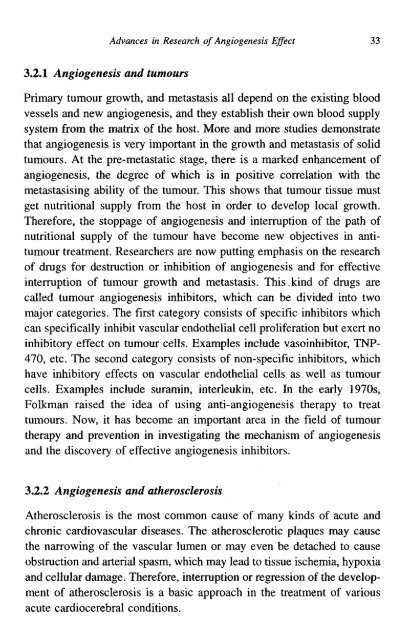Chinese Medicine - Modern Practice (252 pages)
Chinese Medicine - Modern Practice (252 pages)
Chinese Medicine - Modern Practice (252 pages)
- TAGS
- cs5235.userapi.com
Create successful ePaper yourself
Turn your PDF publications into a flip-book with our unique Google optimized e-Paper software.
3.2.1 Angiogenesis and tumours<br />
Advances in Research of Angiogenesis Effect 33<br />
Primary tumour growth, and metastasis all depend on the existing blood<br />
vessels and new angiogenesis, and they establish their own blood supply<br />
system from the matrix of the host. More and more studies demonstrate<br />
that angiogenesis is very important in the growth and metastasis of solid<br />
tumours. At the pre-metastatic stage, there is a marked enhancement of<br />
angiogenesis, the degree of which is in positive correlation with the<br />
metastasising ability of the tumour. This shows that tumour tissue must<br />
get nutritional supply from the host in order to develop local growth.<br />
Therefore, the stoppage of angiogenesis and interruption of the path of<br />
nutritional supply of the tumour have become new objectives in anti-<br />
tumour treatment. Researchers are now putting emphasis on the research<br />
of drugs for destruction or inhibition of angiogenesis and for effective<br />
interruption of tumour growth and metastasis. This.kind of drugs are<br />
called tumour angiogenesis inhibitors, which can be divided into two<br />
major categories. The first category consists of specific inhibitors which<br />
can specifically inhibit vascular endothelial cell proliferation but exert no<br />
inhibitory effect on tumour cells. Examples include vasoinhibitor, TNP-<br />
470, etc. The second category consists of non-specific inhibitors, which<br />
have inhibitory effects on vascular endothelial cells as well as tumour<br />
cells. Examples include suramin, interleukin, etc. In the early 1970s,<br />
Folkman raised the idea of using anti-angiogenesis therapy to treat<br />
tumours. Now, it has become an important area in the field of tumour<br />
therapy and prevention in investigating the mechanism of angiogenesis<br />
and the discovery of effective angiogenesis inhibitors.<br />
3.2.2 Angiogenesis and atherosclerosis<br />
Atherosclerosis is the most common cause of many kinds of acute and<br />
chronic cardiovascular diseases. The atherosclerotic plaques may cause<br />
the narrowing of the vascular lumen or may even be detached to cause<br />
obstruction and arterial spasm, which may lead to tissue ischemia, hypoxia<br />
and cellular damage. Therefore, interruption or regression of the develop-<br />
ment of atherosclerosis is a basic approach in the treatment of various<br />
acute cardiocerebral conditions.
















